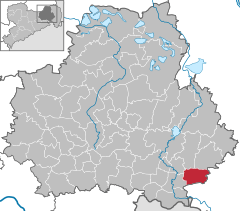Cunewalde
| Cunewalde | ||
|---|---|---|
| ||
 Cunewalde | ||
Location of Cunewalde within Bautzen district 
 | ||
| Coordinates: 51°6′N 14°31′E / 51.100°N 14.517°ECoordinates: 51°6′N 14°31′E / 51.100°N 14.517°E | ||
| Country | Germany | |
| State | Saxony | |
| District | Bautzen | |
| Government | ||
| • Mayor | Thomas Martolock (CDU) | |
| Area | ||
| • Total | 26.62 km2 (10.28 sq mi) | |
| Population (2015-12-31)[1] | ||
| • Total | 4,781 | |
| • Density | 180/km2 (470/sq mi) | |
| Time zone | CET/CEST (UTC+1/+2) | |
| Postal codes | 02733 | |
| Dialling codes | 035877 | |
| Vehicle registration | BZ | |
| Website | www.cunewalde.de | |
Cunewalde (German pronunciation: [ˌkuːnəˈvaldə]) or in the Sorbian language Kumwałd is a community in the district of Bautzen in the east of the federal Free State of Saxony in Germany. It can be found in the Lusatian mountains or hill land between the cities of Bautzen and Löbau in a valley between the hills of the Czorneboh, the Hromadik and the Bieleboh, 499 m (1,622 feet) above sea level. It is one of the biggest villages in upper Lusatia.
History
Cunewalde first has been mentioned in a document from 1222 - but its origins are much older. It seems possible that an inhabited place existed in 1004 at a street between Bautzen and "Böhmisch Zwickau". But the real settlement started in the 13th century when settlers from Franconia and Thuringia came to find a new place to live in this region. At both sides of the "Cunewalder Wasser" – a small river that flows through the valley – each of the settlers got an own piece of land that contained three different types of land-use — meadow, field and wood. This land could have a length of up to 2.5 km (1.6 mi). The village became a typical Waldhufendorf.
The village itself never became a battlefield directly but the people in it also had to suffer under war and its battles. In the years between 1631 and 1633 about half of the inhabitants died because of an epidemic (bubonic plague). In the seven-years-war the valley of Cunewalde has been used by the Austrian general Daun as a place to collect and form its army before the Battle of Hochkirch in 1758.
For about 500 years the village has been a rich peasant village - after the Thirty years War the developing handicraft became more important. It's been supported by exiles from Bohemia who brought with them the practice of weaving. Soon weaving became a practice in the whole village - the "Cunewalder Hemd" was famous in the region because of its astonishing quality.
At the end of the 19th century the small weavers in their small houses had to face a growing textile industry. Cunewalde was one of the first place in the upper Lusatia with big industry-buildings. That time also the infrastructurel network developed - a new railway-connection between Großpostwitz - Cunewalde and further to Obercunewalde has been opened in 1890. Another connection has been created in 1928 between Cunewalde and Löbau. The entire railway-connection was given up in 1998.
.svg.png)